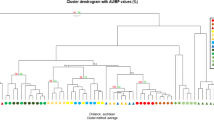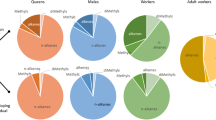Summary
In homospecific groups of ants, each species has its own hydrocarbon profile, on the epicuticle and in the postpharyngeal gland (PPG). When reared together in bispecific groups, workers of both species possess each other's hydrocarbons in both locations. The present study investigated two alternative mechanisms by which a mixed “odour” in artificial groups ofFormica selysi/Manica rubida can be created. Using [1-14C] sodium acetate as a precursor,de novo biosynthesis of hydrocarbons was demonstrated for both species whether reared in homospecific or mixed-species groups. The newly synthesized hydrocarbons occurred on the epicuticle, internally, and in particularly large amounts in the PPG. As expected from their PPG and epicuticular hydrocarbons composition, workersF. selysi synthesized alkanes and alkenes in comparable amounts irrespective of their rearing scheme. Likewise,M. rubida reared in bispecific groups synthesized mostly alkanes with only negligible amounts of alkenes, according to a ratio characteristic toM. rubida workers from homospecific groups and not toF. selysi workers. During dyadic encounters, a transfer of labeled hydrocarbons between nestmates (conspecific in homospecific groups and allospecific in mixed groups) was observed. These results suggest that the formation of the mixed hydrocarbon profile in artificial groups of ants is the result of a transfer of these chemicals between nestmates rather thande novo biosynthesis of the allospecific hydrocarbons. Behaviours like trophallaxis, grooming and body contact that occurred during the encounters mediated such a transfer.
Similar content being viewed by others
References
Bagnères, A.-G., C. Errard, C. Mulheim, C. Joulie and C. Lange, 1991. Induced mimicry of colony odors in ants.J. Chem. Ecol. 17:1641–1664.
Bagnères, A-G. and E. D. Morgan, 1991. The postpharyngeal glands and the cuticule of Formicidae contain the same characteristic hydrocarbons.Experientia 47:106–111.
Bonavita-Cougourdan, A., J.-L. Clément and C. Lange, 1987. Nestmate recognition: The role of cuticular hydrocarbons in the antCompanotus vagus Scop.J. Entomol. Sci. 22:1–10.
Bonavita-Cougourdan, A., J.-L. Clément and C. Lange, 1989. The role of cuticular hydrocarbons in recognition of larvae by workers of the antCamponotus vagus: changes in the chemical signature in response to social environment (Hymenoptera: Formicidae).Sociobiol. 16:49–74.
Breed, M. D., L. E. Snyder, T. L. Lynn and J. A. Morhart, 1992. Acquired Chemical Camouflage in a Tropical Ant.Anim.Behav. 44:519–523.
Carlin, N. F., 1989. Discrimination between and within colonies of social insects: two null hypotheses.Netherl. J. zool. 39:86–100.
Corbara, B. and C. Errard, 1991. The organization of artificial heterospecific ant colonies. The case ofManica rubida/Formica selysi association: mixed colony or parallel colonies.Behav. Proc. 23:75–87.
Crosland, M. W. J., 1989. Kin recognition in the antRhytidoponera confusa. II. Gestalt odour.Anim. Behav. 37:920–926.
Crozier, R. H. and M. W. Dix, 1979. Analysis of two genetic models for the innate components of colony odour in social Hymenoptera.Behav. Ecol. Sociobiol. 4:211–224.
Dettner, K. and C. Liepert, 1994. Chemical mimicry and camouflage.Annu. Rev. Entomol. 39:129–154.
Do Nascimento, N. R. R., J. Billen and E. D. Morgan, 1993. The exocrine secretions of the jumping antHarpegnathos saltator.Comp. Biochem. Physiol. 104B:505–508.
Errard, C., 1994. Development of interspecific recognition behavior in the antsManica rubida andFormica selysi (Hymenoptera: Formicidae) reared in mixed-species groups.J. Ins. Behav. 7:83–99.
Errard, C. and J.-M. Jallon, 1987. An investigation of the development of the chemical factors in ants intra-society recognition.In:Chemistry and biology of social insects (E. Eder and H. Rembold, eds.), pp. 478, Verlag J. Peperny, München.
Franks, N., M. S. Blum and R. K. Smith, 1990. Behavior and chemical disguise of cuckoo antLeptothorax kutteri in relation to its hostLeptothorax acervorum.J. Chem. Ecol. 16:1431–1444.
Hefetz, A., C. Errard and M. Cojocaru, 1992. The occurrence of heterospecific substances in the postpharyngeal gland secretion of ants reared in mixed species colonies (Hymenoptera: Formicidae).Naturwissenschaften 79:417–420.
Henderson, G. and R. D. Akre, 1986. Biology of the myrmecophilous cricket,Myrmecophila manni (Orthoptera: Gryllidae).J. Kansas Entomol Soc. 59:454–467.
Henderson, G., J. F. Anderson and J. K. Phillips, 1990. Internest aggression and identification of possible nestmate discrimination pheromones in polygnous antFormica motana.J. Chem. Ecol. 16:2217–2228.
Hölldobler, B. and E. O. Wilson, 1990.The ants. 732 pp. The Belknap Press of Harvard University Press, Cambridge, Massachusetts.
Howard, R. W., 1993.Insects lipids: chemistry, biochemistry and biology. 467pp. D. W. Stanley-Samuelson and D. R. Nelson, Eds. University of Nebraska Press, Lincoln and London.
Howard, R. W. and G. J. Blomquist, 1982. Chemical ecology and biochemistry of insect hydrocarbons.Ann. Rev. Entomol. 27:149–172.
Howard, R. W., D. W. Stanley-Samuelson and R. D. Akre, 1990. Biosynthesis and chemical mimicry of cuticular hydrocarbons from an obligate predator,Microdon albicomatus Novak (Diptera: Syrphidae) and its ant prey,Myrmica incompleta Provancheri (Hymenoptera: Formicidae).J. Kansas Entomol. Soc. 63:437–443.
Kaib, M., J. Heinze and D. Ortius, 1993. Cuticular hydrocarbon profiles in the slave-making antHarpagoxenus sublaevis and its hosts.Naturwissenschaften 80:281–285.
Katase, H. and H. Chino, 1984. Transport of hydrocarbons by hemolymph lipophorin inLocusta migratoria.J. Biochem. 14:1–6.
Morel, L., R. K. Vander Meer and B. K. Lavine, 1988. Ontogeny of nestmate recognition cues in the red carpenter ant (Camponotus floridanus) — behavioral and chemical evidence for the role of age and social experience.Behav. Ecol. Sociobiol. 22:175–183.
Nowbahari, E., A. Lenoir, J.-L. Clément, C. Lange, A.-G. Bagnères and C. Joulie, 1990. Individual, geographical and experimental variation of cuticular hydrocarbons of the antCataglyphis cursor (Hymenoptera: Formicidae): their use in nest and subspecies recognition.Biochem. System. Ecol. 18:163–173.
Soroker, V., C. Vienne, E. Nowbahari and A. Hefetz, 1994. The postpharyngeal gland as a “Gestalt” organ for nestmate recognition in the antCataglyphis niger.Naturwissenschaften 81:510–513.
Soroker, V., C. Vienne and A. Hefetz, in press. Hydrocarbon dynamics within and between nestmates inCataglyphis niger (Hymenoptera: Formicidae).J. Chem. Ecol.
Vander Meer, R. K., 1986. Chemical taxonomy as a tool for separatingSolenopsis spp.In: Fire ants and leaf-cutting ants, biology and management. (C. S. Lofgren and R. K. Vander Meer, eds.), pp. 316–326, Westview Press, Boulder.
Vander Meer, R. K., D. P. Jouvenaz and D. P. Wojcik, 1989. Chemical mimicry in a parasitoid (Hymenoptera: Eucharitidae) of the fire ants (Hymenoptera: Formicidae).J. Chem. Ecol. 15:2247–2261.
Vander Meer, R. K. and D. P. Wojcik, 1982. Chemical mimicry in the myrmecophilous beetleMyrmecaphodius excavaticollis.Science 218:806–808.
Vienne, C., 1993. Organisation sociale et reconnaissance interindividuelle dans les colonies mixtes artificielles de fourmis. PhDThesis, Paris Nord University, Villetaneuse, France.
Yamaoka, R., 1990. Chemical approach to understanding interactions among organisms.Physiol. Ecol. Japan 27:31–52.
Author information
Authors and Affiliations
Rights and permissions
About this article
Cite this article
Vienne, C., Soroker, V. & Hefetz, A. Congruency of hydrocarbon patterns in heterospecific groups of ants: transfer and/or biosynthesis?. Ins. Soc 42, 267–277 (1995). https://doi.org/10.1007/BF01240421
Received:
Revised:
Accepted:
Issue Date:
DOI: https://doi.org/10.1007/BF01240421




